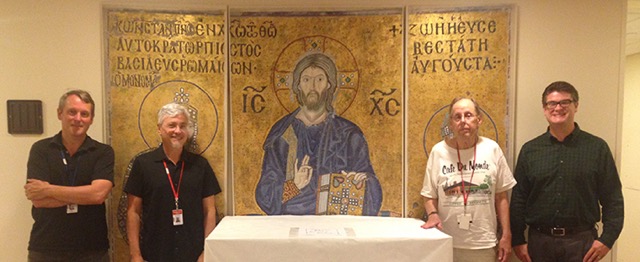By May Wang
Eric McGeer, consultant for Byzantine sigillography, provided a virtual public lecture on the Continuation of John Skylitzes’s Chronicle, which offers Skylitzes’s on-the-ground reconstruction of events before and directly after the pivotal Battle of Mantzikert in 1071. McGeer and John Nesbitt, former research associate in Byzantine sigillography, translated the Greek text for the first time in Byzantium in the Time of Troubles: The Continuation of the Chronicle of John Skylitzes (Brill, 2020). McGeer also embraced the occasion as an opportunity to honor Nesbitt’s contributions to Byzantine Studies at Dumbarton Oaks, especially the seals collection, over the decades.
John Skylitzes was a prominent official in Byzantine jurisprudence who, McGeer posits, was well-positioned to reflect and comment on the events that transpired in the latter half of the eleventh century. A principal source on the history of the middle Byzantine period, Skylitzes’s Chronicle covers the reign of twenty-three emperors from 811 until 1057. A coda known as the Continuation extends the history to 1079, delving into the tumultuous last quarter of the eleventh century that saw usurpations, battles, and betrayals abound. “He was writing at a time of dire crisis in the Byzantine Empire,” McGeer explains, about two decades after the arrival of the Turks and their famous victory over the Byzantines at the Battle of Mantzikert in 1071. In the aftermath of the battle, Emperor Romanos IV Diogenes was captured and eventually put to death.
The Continuation draws significantly on the History of Michael Attaleiates, but McGeer emphasizes that Skylitzes diverges from and adapts Attaleiates’s version of events in telling ways. “We see two sides to the defeat at Mantzikert taking shape,” McGeer says. “One blames Diogenes for the defeat, trying to darken his reputation or besmirch his character; the other side offers sympathy for Diogenes and his terrible fate”; Skylitzes’s Continuation inclines toward the latter. Diogenes was betrayed and captured at the Battle of Mantzikert and later blinded and put to death by his rivals for the throne. “Diogenes’s fate seems to have sat very heavily in the memory of the Byzantines of his time,” says McGeer, and later retellings like Skylitzes’s cast him as an emperor who went out to face the Turkish threat but ended up being betrayed by his own people. Though Skylitzes as a court official might have known some witnesses to Mantzikert, McGeer suggests the historian benefited from some temporal distance from the pivotal event; “the regime had changed and some people who had been active in the 1060s were dead, so he was a bit freer to name names or to apportion blame.”
But Skylitzes was still a court official, after all, and was closely attuned to the imperial interests of his own time. Alexios I Komnenos’s accession to power in 1081 began to stabilize the tumult that followed Mantzikert. His court, influenced by his pious mother Anna Dalassene, was concerned with rehabilitating the reputation of the Komnenian line—which had a tenuous claim to the throne—and retelling the empire’s history in a more pious and moral light. “A need for placating God and restoring a concept of righteousness seeps into Skylitzes’s narrative,” says McGeer. “He realized the prevailing mindset of strict asceticism and piety favored by the emperor’s mother and made the history into a morality tale.”
The pious influence of Anna Dalassene on the Komnenian court evident in the Continuation is reinforced by her seals held in the Dumbarton Oaks collection. McGeer and Nesbitt have both extensively contributed to the catalogues of our 17,000 Byzantine lead seals over the decades. “We’re very lucky many of the people mentioned in the Continuation issued seals that have come into the Dumbarton Oaks collection,” says McGeer. Seals from the eleventh century are particularly illustrative and “add color” to the occasionally dry textual histories. The inscriptions and iconography of Dalassene’s seals, for example, attest to her strict piety, and she frequently styled herself as the emperor’s mother, confirming other written accounts of her influence at the imperial court and on a text like the Continuation.
In addition to the importance of the Continuation’s perspective on this critical period in Byzantine history, McGeer emphasizes the foresight of his collaborator John Nesbitt in this and countless other projects. “It was John who suggested we start translating the Continuation— typical John to suggest very good subjects,” says McGeer. “The lecture was in a sense to thank him on behalf of many people for all the advice and counsel he has given over the years.” Nesbitt worked with the Byzantine seals collection starting in the 1970s, contributing to six volumes in the Catalogue of Byzantine Seals. The most recent volume, a groundbreaking study of 572 anonymous iconographic seals in the collection by Father John Cotsonis, was inspired by Nesbitt’s knowledge of this unusual subset of seals. The volume adds to the ongoing project of increasing access by digitizing and cataloguing the seals collection, the largest in the world.

The seals offer “glimpses into a world that is gone,” as McGeer describes it, enriching histories like the Continuation and offering a level of detail on Byzantine life for specialists and nonspecialists alike. McGeer also hopes the lecture provided an opportunity for the almost 180 virtual attendees to reflect on the range and depth of John Nesbitt’s work at Dumbarton Oaks.
May Wang is postgraduate writing and reporting fellow at Dumbarton Oaks. Image: The medieval Armenian city of Ani now in Turkey as viewed from Armenia, from the cover of “Byzantium in the Time of Troubles: The Continuation of the Chronicle of John Skylitzes (1057–1079)” (image: courtesy of Brill)

